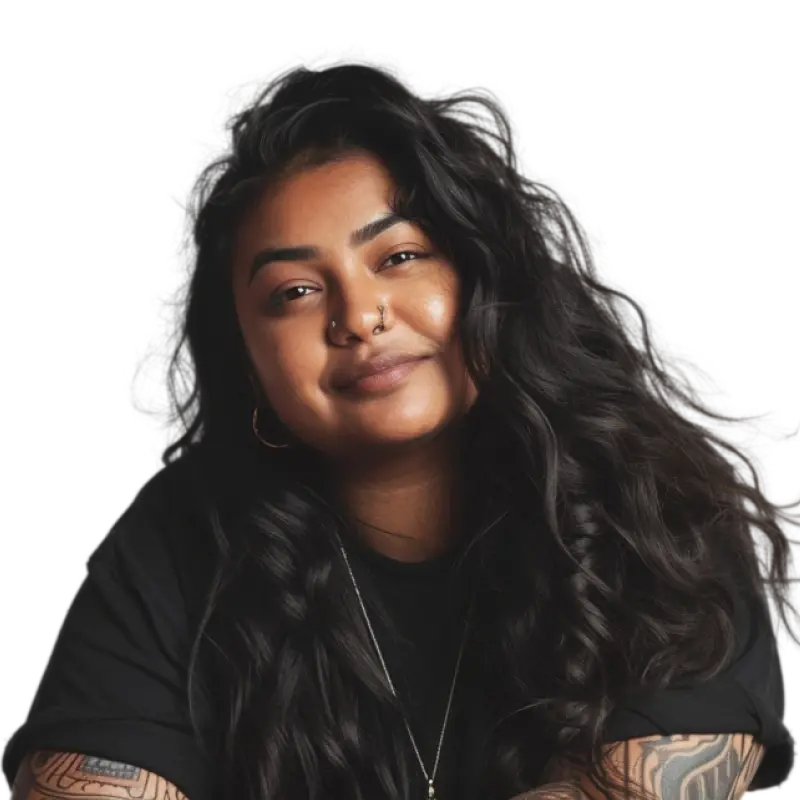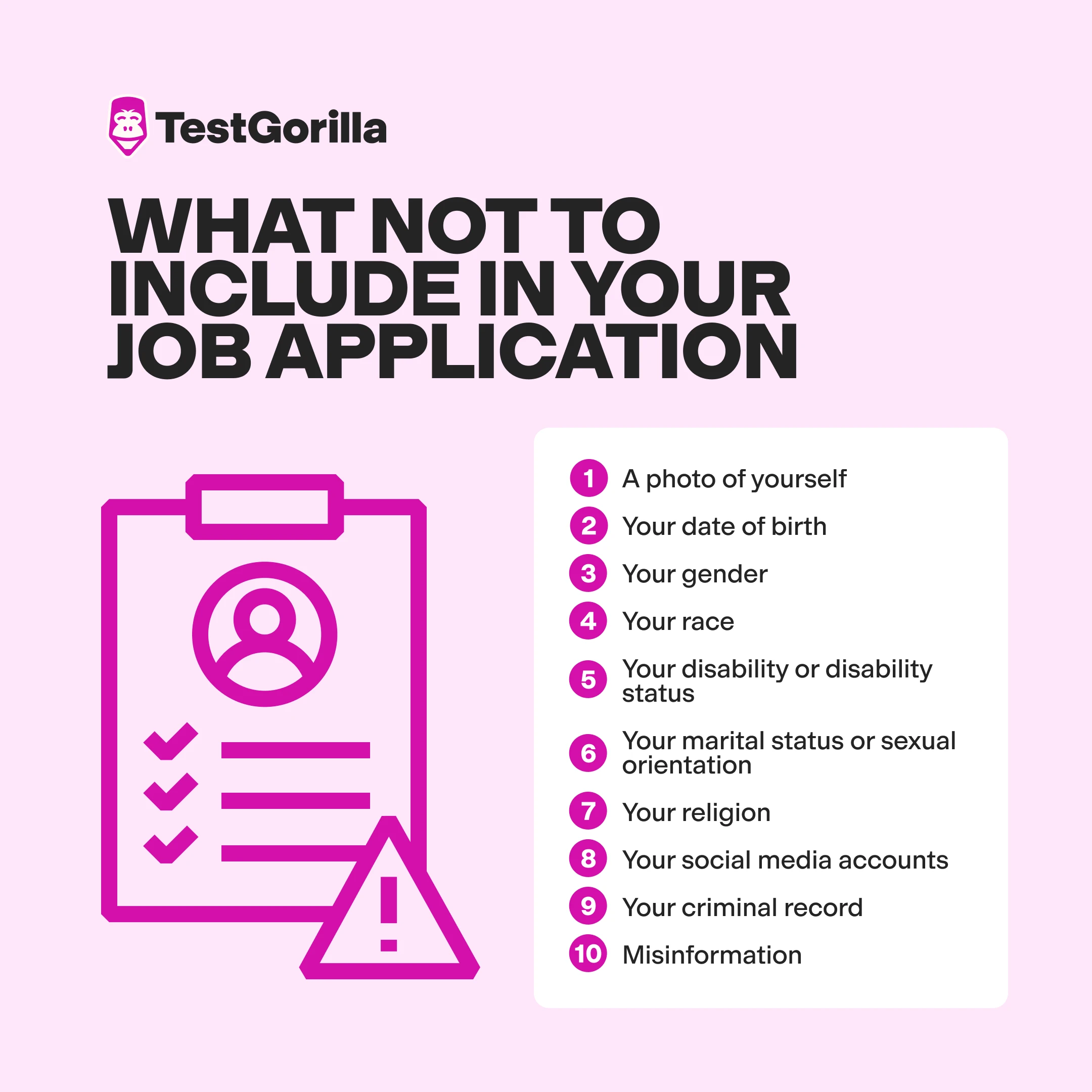What to include – and not to include – on your next job application
When writing your next job application, less is often more.
Including certain personal information - like your photo, race, age, or marital status - can invite unconscious bias and discrimination into the hiring process. Worst of all? It distracts hiring teams from what matters most: your skills.
In this article, learn what to include and - more importantly - not to include in your job application to attract the attention of the hiring team, reduce the risk of unconscious bias, and secure your next job.
Table of contents
What is a job application?
A job application is a form employers ask applicants to complete to express their interest in a role.
Are you a job seeker?
Visit our job seeker hub to get help with your assessment, find your dream job and more.
The contents of a job application vary between employers and roles. Generally, they ask a candidate to:
Provide information about their qualifications and experience
Respond to specific selection criteria
Attach a resume or CV
Hiring teams use job applications to decide which candidates progress in the hiring process.
What not to include in your job application
Here’s what you should avoid including on your resume or job application.
1. A photo of yourself
Candidates often think adding a photo to their job application helps them stand out to the hiring team.
But including your photo can make you stick out for the wrong reasons.
People on the hiring team may make assumptions about you based on your photo, including your race, age, or disability. This potentially allows unconscious bias to influence their decision to invite you for an interview.
2. Your date of birth
Including your date of birth in your resume or job application gives hiring teams an easy way to calculate your age. Once they know this, it opens the door for potential unconscious bias to affect their decision-making.
For example, if a hiring manager knows a female applicant is in her 30s, they could assume she’s considering having children and take this into account when deciding who to shortlist for interviews.
3. Your gender
Some candidates ask, “Should gender be included in a resume or job application?”
Our response? While a hiring team may be able to assume your gender from other details in your application, you shouldn’t explicitly state it in your job application.
As anti-discrimination law recognizes, your gender is irrelevant to your ability to perform in a role.
4. Your race
Like gender, race has no bearing on whether or not you can do a job. To reduce the risk of potential bias during the hiring process, leave this detail out of your job application.
By doing this, hiring teams can focus on your skills and support a fair and equitable hiring process.
5. Your disability or disability status
You don’t need to disclose your disability or disability status in an initial job application.
Under federal law, hiring teams can only ask you disability-related questions once they’ve made a conditional offer. They can ask at an earlier stage whether you require accommodations to do the job and, if so, what those accommodations are.
Unfortunately, disclosing a disability at this early stage of the hiring process may open you up to discrimination. A potential employer may put your application in the “no” basket without considering it properly to see if you have the necessary skills.
6. Your marital status or sexual orientation
Your relationship status and sexual orientation are entirely irrelevant to your ability to succeed in the workplace. By including these in a job application, a hiring team may make assumptions that impact their decision-making.
Say an employer is recruiting for a role that involves a lot of travel. If they know a candidate is married, they may assume this makes it hard for the candidate to travel and decide not to proceed with their application.
7. Your religion
Like gender, race, and relationship status, religion doesn’t affect your ability to perform in a role. However, including it in your application introduces unnecessary personal information that can distract hiring teams from focusing on your skills and capabilities.
8. Your social media accounts
Some employers use social media screening to learn more about applicants’ backgrounds during the hiring process.
Generally speaking, there’s nothing stopping employers from looking at publicly available online information. However, some states ban employers from asking applicants and employees for social media usernames and passwords or sharing content from their profiles.
Even if it’s lawful for an employer to look at your online presence, they can’t use the information they find to discriminate against you during the hiring process.
9. Your criminal record
Does your job application have a question asking you if you have a criminal record? Think twice before checking the box next to it.
Many states, counties, and cities have Ban the Box laws that prevent employers from asking about your criminal history at this stage of the hiring process.
Unfortunately, there’s still a stigma around hiring applicants with criminal histories. Ban the Box laws aim to address this and ensure people with criminal histories have access to equal employment opportunities. Check whether any local laws apply before checking the box.
10. Misinformation
Some candidates may be tempted to get a little creative on their job applications.
And we get why. There’s a lot of pressure when looking for a job to present yourself in the best possible light and tick every box on a job application.
But dishonesty in a job application won’t get you far. Employers usually uncover the truth during the recruitment process or once you’ve been hired. Not only does lying on your job application set a bad tone from the start, but it can also get you in legal trouble.
Be honest in your job application so potential employers can clearly see what you bring to the table.
Why shouldn’t personal data like age, race, or gender be included on a resume?
As a candidate, standing out to employers is essential. You want them to get to know you as an individual and understand what sets you apart from other candidates.
So, why not include personal data on a resume or job application?
As we’ve covered, the answer is simple: Doing so could cause some employers – intentionally or not – to use your data to discriminate against you during the hiring process.
With some rare exceptions, federal law prohibits employers from discriminating against job applicants based on these protected characteristics:
Race
Color
Religion
Sex (including sexual orientation, gender identity, and pregnancy)
National origin
Age
Disability
Genetic information
State-level anti-discrimination laws may identify additional protected characteristics.
Unfortunately, despite these laws, employment discrimination still happens. Removing this information from your job application reduces the risk of unconscious bias and discrimination affecting the hiring process.
What to include in your job application
Now, what should you cover in your next application? Here are the four key things to include to show hiring teams your true potential without the risk of unconscious bias
1. Qualifications and experience
Most job applications ask you to detail your relevant qualifications and experience. But don’t just list your previous job titles and responsibilities – focus on the skills you developed or demonstrated.
Highlight specific achievements, projects, and tasks that showcase your abilities relevant to the job, too. This is a great way to identify transferable skills that will let you successfully navigate a career change.
2. Basic contact details
At a minimum, include your email so the hiring team can reach you about your application. (Still using the email you created in high school? Time to update it to a more professional one!)
You might include your mobile phone number as well. Employers usually don’t need your physical address at this stage, though, so leave this out.
3. Portfolio
If you’re applying for a role involving creative or technical work, including a link to your portfolio is a great way to showcase your skills. For example, portfolios may be relevant when applying for software developer, graphic design, copywriting, and architecture roles.
This gives hiring teams objective, tangible evidence of your experience and abilities, reducing the risk of unconscious bias entering the hiring process.
4. References
Adding references to your application helps hiring managers and teams gain more insights into your experience and workplace behaviors.
Your references should be people who can speak to your professional qualifications and experiences rather than personal connections or information. Just make sure you check with your references before sharing their details.
Elevate your job applications with TestGorilla’s skills assessments
At TestGorilla, we believe in skills assessments over resumes. They’re the best way for a potential employer to gain objective insights into your skills, workplace behaviors, culture add, and more. With this information, hiring teams can decide who fits the role best without unconscious bias clouding their judgment.
That’s why we’ve created our own skills-first job board, which lets you apply for and match with jobs by taking skills assessments.
Want to learn more? Sign up for TestGorilla’s job board today and learn more about how our skills assessments can help you find your next role!
Related posts
You've scrolled this far
Why not try TestGorilla for free, and see what happens when you put skills first.
Latest posts
The best insights on HR and recruitment, delivered to your inbox.
Biweekly updates. No spam. Unsubscribe any time.

Skills tests to hire the best
Our screening tests identify the best candidates and make your hiring decisions faster, easier, and bias-free.
Free resources
A step-by-step blueprint that will help you maximize the benefits of skills-based hiring from faster time-to-hire to improved employee retention.
With our onboarding email templates, you'll reduce first-day jitters, boost confidence, and create a seamless experience for your new hires.
This handbook provides actionable insights, use cases, data, and tools to help you implement skills-based hiring for optimal success
A comprehensive guide packed with detailed strategies, timelines, and best practices — to help you build a seamless onboarding plan.
This in-depth guide includes tools, metrics, and a step-by-step plan for tracking and boosting your recruitment ROI.
Get all the essentials of HR in one place! This cheat sheet covers KPIs, roles, talent acquisition, compliance, performance management, and more to boost your HR expertise.
Onboarding employees can be a challenge. This checklist provides detailed best practices broken down by days, weeks, and months after joining.
Track all the critical calculations that contribute to your recruitment process and find out how to optimize them with this cheat sheet.

















